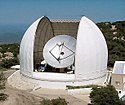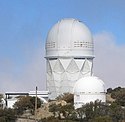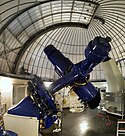Kitt-Peak-Nationalobservatorium

Das Kitt-Peak-Nationalobservatorium (Kitt Peak National Observatory) ist ein großes astronomisches Observatorium auf dem Gipfel des 2095 m hohen Kitt Peak in der Sonora-Wüste, 65,4 km (Luftlinie) südwestlich von Tucson, Arizona.
Der Kitt Peak wurde im Jahr 1958 als Standort für das US-amerikanische Nationalobservatorium ausgewählt, das noch heute der Betreiber ist.
Heute beherbergt das Observatorium rund 20 optische Teleskope, von denen das Mayall Telescope und das WIYN Telescope mit Hauptspiegeln von 4 m und 3,5 m Durchmesser die größten sind.[1] Das Spacewatch-Projekt betreibt zwei Spiegelteleskope von 1,8 m und 0,9 m Durchmesser zur Beobachtung von Asteroiden und Kometen, insbesondere zur Auffindung von erdnahen Objekten. Zur Beobachtung der Sonne stehen am Kitt Peak das McMath-Pierce Solar Telescope, das größte Sonnenteleskop der Welt, sowie das Kitt Peak Vacuum Telescope zur Verfügung. Schließlich beherbergt der Kitt Peak auch noch zwei Radioteleskope von 12 m und 25 m Durchmesser. Letzteres wird in Verbindung mit anderen Radioteleskopen im Very Long Baseline Array als radioastronomisches Interferometer verwendet.
(2322) Kitt Peak, ein Asteroid des äußeren Hauptgürtels, wurde nach dem Observatorium benannt.[2]
Abbildungen
- Gebäude des Mayall Telescope
- Mayall Telescope
- Kuppel des WIYN-Teleskops
- Das WIYN-Teleskop bei geöffneter Kuppel
- 12-m-Radioteleskop
- 2,3-m-Bok-Teleskop, nach Bart J. Bok benannt, first light im Jahr 1969
- 1963 errichtete Kuppel, die das 1921 gebaute Steward-Teleskop mit 36 Zoll Apertur beherbergt. Rechts: 2,1-m-Teleskop
- (c) kallahar, CC BY 3.0Radioteleskop, 25 m Apertur, Teil des Very Long Baseline Array
- McMath-Pierce Solar Telescope
- Innenansicht des Solar-Teleskops
Siehe auch
- Paranal-Observatorium
- La-Silla-Observatorium
- Cerro Tololo Inter-American Observatory
- European Extremely Large Telescope
Weblinks
- Homepage des Kitt Peak National Observatory (englisch)
- WIYN-Korrektor (englisch; PDF-Datei; 387 kB)
- Die hellen Planeten am McMath-Pierce-Sonnenteleskop APOD 16. März 2012
Einzelnachweise
- ↑ http://ast.noao.edu/observing/current-telescopes-instruments#kpno
- ↑ Lutz D. Schmadel: Dictionary of Minor Planet Names. Fifth Revised and Enlarged Edition. Hrsg.: Lutz D. Schmadel. 5. Auflage. Springer Verlag, Berlin, Heidelberg 2003, ISBN 3-540-29925-4, S. 186, doi:10.1007/978-3-540-29925-7_2323 (englisch, 992 S., Originaltitel: Dictionary of Minor Planet Names. Erstausgabe: Springer Verlag, Berlin, Heidelberg 1992): “1954 UQ2. Discovered 1954 Oct. 28 at the Goethe Link Observatory at Brooklyn, Indiana.”
- ↑ J. J. Nassau: The Burrell Telescope of the Warner and Swasey Observatory. In: Astrophysical Journal. bibcode:1945ApJ...101..275N.
Koordinaten: 31° 57′ 48″ N, 111° 36′ 0″ W
Auf dieser Seite verwendete Medien
Autor/Urheber: James Jones from Phoenix, AZ, USA, Lizenz: CC BY 2.0
center left: Steward Observatory 0.9-meter telescope, the oldest on Kitt Peak. It was installed in 1921, right: KPNO 2.1m
Autor/Urheber: NOIRLab/NSF/AURA, Lizenz: CC BY 4.0
The WIYN 3.5m telescope, showing the multi-fiber spectrograph known as Hydra mounted to its dedicated Nasmyth port.
Autor/Urheber: Jörg Weingrill from Potsdam, Germany, Lizenz: CC BY 2.0
Dome of the 3.5m WIYN telescope
Autor/Urheber: Jeff Mangum, NRAO, Lizenz: CC BY-SA 3.0
Photo of 12 meter radio telescope on Kitt Peak, Arizona, USA. Photo taken by Jeff Mangum of the NRAO, taken from http://aro.as.arizona.edu/.
Autor/Urheber: Tom.Reding, Lizenz: CC BY-SA 3.0
Burrell Schmidt telescope at the Warner & Swasey Observatory at Kitt Peak National Observatory, Arizona, United States.
Autor/Urheber: KPNO/NOIRLab/AURA/NSF/P. Marenfeld, Lizenz: CC BY 4.0
At Kitt Peak National Observatory (KPNO), a Program of NSF’s NOIRLab located near Tucson, Arizona, it’s unusual to have a cloudy night like this Image of the Week. The high desert climate and mountaintop location make it a great environment for world-class scientific research. The 19 research telescopes on the peak experience over 300 clear nights a year, allowing near year-round observing opportunities. This is great for the many exciting projects at KPNO. For example, the Dark Energy Spectroscopic Instrument (DESI), led by the US Department of Energy, is acquiring the spectra of tens of millions of galaxies and quasars to construct a 3D map that will reveal the effects of dark energy in the Universe. Another instrument, NEID, funded by the joint NASA/NSF Exoplanet Exploration Program, is designed to measure the motion of nearby stars with extreme precision with the WIYN 3.5-meter Telescope. This image was taken before the 2022 Contreras Fire, which affected KPNO. Read more here.
Autor/Urheber: KPNO/NOIRLab/NSF/AURA/P. Marenfeld, Lizenz: CC BY 4.0
The Dark Energy Spectroscopic Instrument (DESI) is installed on the Nicholas U. Mayall 4-meter Telescope at Kitt Peak National Observatory near Tucson, Arizona. The most powerful multi-object survey spectrograph in the world, DESI is an international science collaboration managed by the Lawrence Berkeley National Laboratory with primary funding for construction and operations from the US Department of Energy’s Office of Science.







![Burrell Schmidt telescope, 24 Zoll Apertur, betrieben seit dem Jahr 1941[3]](http://upload.wikimedia.org/wikipedia/commons/thumb/5/5f/Burrell_Schmidt_telescope_at_the_Warner_%26_Swasey_Observatory_at_Kitt_Peak.jpg/110px-Burrell_Schmidt_telescope_at_the_Warner_%26_Swasey_Observatory_at_Kitt_Peak.jpg)














